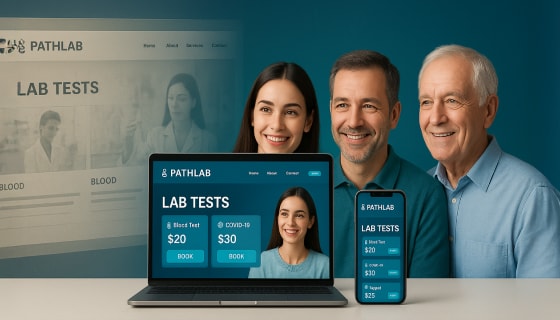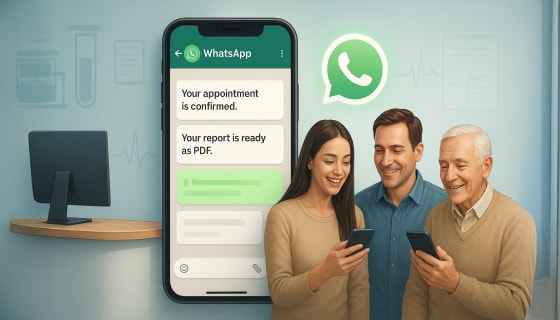The days of relying solely on doctor referrals or word-of-mouth are fading. Today’s patients are in control—they research, compare, and make decisions digitally. From searching symptoms on Google to checking surgeon reviews and scanning social media, patients take time to validate every choice before booking a consultation.
This shift has made your online presence just as significant as your medical credentials. It’s no longer about being available—it’s about being findable and trustworthy in the right places online.
In this blog, we’ll explore the new journey patients are taking on search engines and voice queries, from reading reviews and checking local listings, and how joint surgeons can stay ahead in this digital-first world.
Let’s start with the obvious first stop: Google.
The Role of Google in the Patient’s First Step
Did you know Google receives more than 1 billion health-related questions every day? That’s about 70,000 searches per minute, and a large share of those are patients looking for doctors, clinics, or treatment options nearby.
It’s no surprise, then, that for someone considering joint replacement, their first step is often a search like:
- “Best knee replacement surgeon near me”
- “Top-rated orthopedic clinic in [city]”
- “How to choose a joint replacement surgeon”
Google doesn’t just process these queries; it understands them. Patients type in everything from long, detailed questions to short keywords. Some are voice searches phrased conversationally:
- “Who is the best hip surgeon around me with good reviews?”
- “Orthopedic specialist that accepts Medicare near me.”
Others are quick and to the point:
- “Knee surgeon Mumbai”
- “Hip replacement cost”
This variation means Google surfaces results based not just on keywords, but on intent, location, and user context. That’s why it’s crucial to be visible across different types of results, especially the ones patients trust most.
The first page of Google captures over 90% of all clicks. For patients in need of care, they rarely scroll past the top listings. Here’s where visibility happens:
- Organic Listings: These are earned through SEO—high-quality content, mobile-friendly pages, and fast load times all contribute. Ranking here builds long-term credibility
- Google Ads (Paid Listings): These appear at the top and are ideal for targeting specific procedures, locations, and types of insurance. A well-run PPC campaign gets you in front of patients right when they’re searching.
- Google Map Pack (Local 3-Pack): This is the block of local business listings that appears in response to location-based searches. It includes your clinic name, reviews, phone number, and “directions” button—all critical for walk-ins or nearby searches.
Whether it’s a typed query or a quick voice command, Google is often the first place patients turn to when seeking answers as more people use their phones or personal assistants, such as Google, Alexa, and Siri, while on the go, voice search is becoming a natural part of how patients search for care.
In the next section, we’ll examine how voice search is transforming the way patients find joint replacement services.
The Power of Voice Search: Patients Asking for Solutions
According to Google, over 27% of the global online population now uses voice search on mobile devices. As smart speakers like Alexa, Google Nest, and Siri become household staples, people are becoming accustomed to asking questions out loud, especially when seeking local, time-sensitive services such as healthcare.
Think about it:
Typing “knee surgeon near me who accepts Blue Cross” takes effort. But saying “Hey Siri, who’s the best knee replacement doctor near me that takes Blue Cross?” is faster and more natural.
Voice search has changed the way people phrase their queries. Instead of short, choppy keywords, people now speak in full questions and expect localized answers.
This leads us to two essential concepts:
Long-Tail Keywords
Long-tail keywords reveal clear intent, and voice searches are often filled with them. Patients don’t just ask what; they ask who, where, how much, and when. A long-tail keyword is a more specific, conversational search phrase that typically contains three or more words.
Example:
❌ Short keyword: “knee surgeon”
✅ Long-tail: “best knee replacement surgeon near me for seniors”
Local Intent
Local intent refers to the searcher’s intention to find a service in their immediate vicinity. Search engines pick up on this intent and prioritize nearby results, especially if your clinic is listed on Google Business Profile and optimized for local SEO.
Example:
🗣️ “Orthopedic specialist open now in Chicago”
🗣️ “Hip surgeon near me who speaks Hindi”
If you want your name to appear when someone asks their phone or smart speaker for help, here are a few practical tips to guide you.
- Use Natural Language on Your Website: Write in a way that people speak, not how robots read. Voice assistants pull snippets that match the way people ask questions.Instead of:
“Orthopaedic services provided for hip and knee injuries.”
Try:
“Need a hip or knee replacement? Our surgeons are here to help.”
- Make Your Site Fast and Mobile-Friendly: Voice searches occur mostly on mobile devices, and Google ranks fast, responsive sites higher. A clinic website that loads in 1.5 seconds is more likely to appear in search results than one that takes 4 seconds to load.You can use tools like PageSpeed Insights to check your mobile speed.
- Use Local Business Schema: Add structured data (schema markup) to your website to help Google better understand your location, services, and hours of operation. This increases your clinic’s likelihood of appearing in spoken search results and Google’s Local Pack.Example: Add a schema that tells Google:
- You’re a “MedicalClinic”
- You offer “Joint Replacement Surgery”
- You’re located in “Dallas, TX”
- You’re open “Mon–Sat, 9 am–6 pm”
It’s also important to consider where patients are searching from. Today, over 60% of health-related searches happen on mobile devices. Patients often ask for help while commuting, sitting in waiting rooms, or even during conversations with family, frequently using their phones or smart speakers.
That means your website must deliver a fast, seamless experience on smaller screens.
What Mobile-First Really Means:
- Keep load times under 2 seconds
- Use click-to-call buttons for instant action
- Show contact info and hours right at the top
- Avoid clutter—make navigation clean and intuitive.
With voice search, patients often get their answers straight from what Google shows first. And most of the time, that’s not your website—it’s your business profile. Let’s examine how your Google listing can help you appear exactly when and where patients are searching.
Google My Business and Local Listings (the must-haves)
with your clinic name, address, reviews, and hours, right at the top or on the right side of the screen.
In fact, for local searches, Google’s first response is almost always a local map pack, not a website.
That’s why your Google Business Profile matters. It’s often the first thing patients see about your practice. Even before your website, your Google My Business (GMB) listing provides them with your reviews, photos, contact information, and directions. A complete, up-to-date profile signals credibility and its action drive. Patients can call, book, or get directions directly from your listing—no extra steps needed.
Let’s walk through what makes a standout profile:
Categories & Services
Ensure your primary category is accurate (e.g., Orthopedic Surgeon, Medical Clinic) and add specific services, such as Knee Replacement, Hip Surgery, or Minimally Invasive Joint Care.
Example:
“Orthopedic Surgeon in Austin, TX – Specializing in Total Knee Replacement and Robotic Hip Surgery.”
Photos and Videos
Upload clear images of your clinic, waiting room, surgical team, and even short clips of patient education or testimonials. People trust what they can see. Photos make your practice feel real and relatable.
Business Description
Use this space to speak directly to your patients. Highlight your expertise, approach to care, and what makes you stand out.
Example:
“We’re a specialized joint care center offering personalized knee and hip replacement surgeries using advanced, minimally invasive techniques.”
Reviews and Responses
Encourage happy patients to leave reviews. And always reply, whether the feedback is positive or negative.
Example:
- “Thank you, Mrs. Sharma, for your kind words. We’re glad your recovery is going well!”
- “Sorry to hear about the wait time, Mr. Patel. We’re reviewing our scheduling to serve you better.”
Operating Hours and Contact Info
Keep this 100% accurate. If you’re open Saturdays, mention it. If you offer emergency consultations, say so.
The bottom line is to keep your NAP (Name, Address, Phone number) consistent across all platforms. Google checks for this—mismatched details can hurt your local SEO.
Don’t Stop at Google: Expand to Other Local Listings
- Apple Maps
- Bing Places
- JustDial / Practo (for India)
- Healthgrades / Zocdoc (for US)
Your Google Business Profile makes it easier for patients to reach out with confidence. But before they make that call or book online, there’s one more thing they almost always check: Reviews!
Why Reviews Matter More Than Ever
When it comes to choosing a joint replacement surgeon, patients often trust the opinions of other patients. After checking your website and Google listing, most will head straight to the review section—and that’s often the deciding factor.
In fact, over 74% of patients say they won’t book a healthcare appointment without first reading online reviews. Platforms like Google, Facebook, and Yelp are now central to how patients evaluate providers.
Your qualifications matter, but a heartfelt review saying, “I can walk pain-free after years of struggle” carries more emotional weight.
How to Build and Manage Strong Reviews
You don’t need dozens of tactics—just a few well-timed steps can lead to powerful patient reviews that build credibility where it matters.
Ask at the Right Time
The best time to ask for a review is when the patient is satisfied or right after a successful surgery, follow-up, or recovery milestone.
A simple nudge like “Would you be willing to share your experience on Google? It really helps other patients make informed choices.” can go a long way.
Respond to Every Review
A polite, timely response shows you care, whether it’s a thank you or an apology.
Examples:
- “We’re so glad your recovery is going well, Mr. Sharma. Thank you for the kind words!”
- “We appreciate your feedback, and we’re working to improve our wait times. Thanks for letting us know.”
Be Transparent, Not Perfect
No one trusts a clinic with 200 five-star reviews and no criticism. A few neutral or even negative reviews, with respectful responses, demonstrate authenticity.
Bonus: Reviews Help SEO Too!
Positive reviews improve your chances of ranking higher in local search results, especially in Google’s local pack. Google uses both the quantity and quality of reviews as indicators of trust.
In today’s digital world, your patients speak for you, and future patients are listening closely. Let’s wrap it up with a quick recap of what we’ve covered.
Conclusion
Most patients won’t tell you this, but by the time they walk into your clinic, they’ve already made up their minds. Not because of a referral, but because of what they found on the internet. Your presence on Google, the reviews they read, even how your clinic appears on Maps—all of it shapes their decision long before the first handshake.
This shift means that traditional referrals are no longer the final word; patients now have the authority to validate everything. They want to feel confident, informed, and in control. That confidence often starts with a quick search, and what they find in those few seconds can either open the door or quietly close it.
At ZealousWeb, we specialize in helping healthcare providers like you stay visible, trusted, and top-of-mind through innovative digital strategies—SEO, local search, PPC, and reputation management tailored for your practice. Get in touch with us today and let’s make sure they find you when it matters most.














